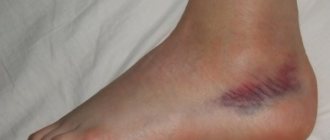Hirschsprung's disease in children was described by a pediatrician back in the 19th century, specifically in 1887. The disease is named after the doctor who first described it, Harold Hirschsprung. Its first name was intestinal gigantism. Later it became known as congenital intestinal aganglionosis.
The disease has been known for a long time, but it has been studied little. It's good that this problem doesn't happen that often. It is detected in only one newborn out of five thousand. More often affects boys. More often, the pathology is diagnosed in children with Down syndrome. This problem almost never occurs in teenagers.
Description of the disease
Hirschsprung's disease is a congenital syndrome of abnormal development of the large intestine. During the disease, the movement of feces is disrupted due to the lack or absence of nerve endings in the intestine. The anomaly leads to the fact that the area of the affected intestine does not take part in the digestive process. The affected intestinal walls do not contract, food stops moving and is retained in the healthy section.
As a result of the accumulation of feces and gas formation, stretching and thinning of the intestine occurs. This contributes to the appearance of persistent constipation, emptying occurs once a week, or even less often. This often lasts for many years until the disease is diagnosed and treatment is started.
Usually the pathology manifests itself immediately after birth. The clinical picture of Hirschsprung's disease in newborns is associated with the duration and height of the position of the anomaly relative to the anus. The longer and higher the aganglionosis, the sharper and more noticeable the symptoms of the disease.
What does the intestine look like with Hirschsprung syndrome?
Photo
The photo below shows images of what congenital megacolon or aganglionosis of the large intestine looks like:
The area of the intestine, the walls of which do not have nerve cells, increases significantly in size
An example of a lesion in the sigmoid rectum
A characteristic symptom of the disease is bloating, a noticeable increase in its volume
Causes of Hirschsprung's disease
Statistics from morphological studies have established the following factors contributing to the development of aganglionosis:
- disruption and mutation of DNA structure: nerve endings that contribute to the correct digestion process are formed in the embryo at 5-12 weeks of pregnancy, but sometimes they do not develop fully, this causes intestinal aganglionosis,
- hereditary factor: Hirschsprung disease is considered a hereditary genetic disease; if a family member suffers from the pathology or is a carrier, then the child has an increased chance of inheriting it,
- negative conditions for the expectant mother: in areas where radiation levels are off the charts, most children have congenital Hirschsprung disease,
- diagnosed fetal hypoxia,
- Down syndrome or rickets,
- disturbances in the functioning of the endocrine system of a pregnant woman,
- action of chemical elements,
- viral infections suffered during pregnancy.
Deviations in the structure of DNA can cause disease
Causes of pathology
The disease was described back in the nineteenth century, but even today there is no exact information why such an anomaly appears. The reasons are being studied, but are not fully understood. Pathology appears in utero. Starting from the fifth week of pregnancy, the fetus begins to form nerve cells that regulate the digestion process. Formation begins in the oral cavity and then spreads throughout the esophagus, covering the stomach and the entire tract to the posterior opening.
The lesions are a couple of centimeters long, and sometimes extend along the entire length of the intestine.
Why does the formation process suddenly stop at a certain segment:
- Some scientists suggest that changes in DNA are possible. That is, a mutation occurs on the tenth DNA chromosome in a certain area.
- The second possibility is genetic predisposition.
Research is being carried out to determine the reasons. So far, it has been accurately revealed that in 50% of those who became ill, no patients with a similar pathology were identified in their family.
Scientists cannot say for sure what causes this problem. But surgeons know how to deal with it. And they return most of their patients to normal life.
Symptoms of Hirschsprung's disease
Signs of the disease in newborns and infants up to one year:
- delay in the passage of original feces (meconium) for more than a day,
- frog belly (swollen abdominal cavity) in a child,
- increased accumulation of gases,
- refusal to eat due to intoxication of the body,
- vomit,
- painful sensations in the abdomen,
- ascites (abdominal dropsy),
- sleep disturbance,
- anxiety, tearfulness,
- pulling the legs towards the stomach,
- insufficient weight gain.
Later symptoms of the disease are:
- anemia (low hemoglobin),
- chronic eating and digestive disorders,
- distortion of the chest structure,
- fecal stones.
The intestines do not completely defecate. The feces look like tape and have an unpleasant odor.
Enlarged abdomen in a child with Hirschsprung's pathology
Period after surgery
In the postoperative period, there is a risk of intestinal infection. If parents notice bloating, vomiting, diarrhea, or fever in their child, it is important to seek medical help immediately.
Photo: Feeling unwell after surgery
The child recovers after the operation for six months. During this period, almost all children experience cases of involuntary passage of feces. Sometimes there is stool retention. In such cases, intensive rehabilitation is required.
After six months, the child’s stool returns to normal, body weight returns to normal values, and the child develops similarly to his peers. And yet, the child must be registered with a specialist for at least a year after the operation. At this time, parents should monitor the child’s condition and keep his body in good shape (exercise, good nutrition, strengthening the immune system).
Stages of the disease and its classification
Hirschsprung's disease code according to ICD-10: Q43.1. Anatomical classification of the disease according to Lenishkin A.I.:
- rectal: the perineal part of the rectum is affected,
- rectosigmoid: pathology of the center of the rectum or lower colon,
- subtotal: left-sided damage to half of the colon with flow to the right,
- total: the entire colon is affected, extending into the lower small intestine.
Depending on the severity of the disease, there are 3 stages.
- The compensated (initial) stage is characterized by constipation from an early age. This problem can be easily eliminated with enemas.
- The subcompensated stage is marked by the ineffectiveness of enemas and poor health of the patient. Weight is lost, abdominal pain appears, shortness of breath worries, and proper metabolism is lost.
- The decompensated stage includes chronic pain in the abdominal cavity, heaviness, and in some cases, intestinal obstruction may develop. Medicinal laxatives and cleansing enemas do not promote effective bowel movements.
What does the affected intestine look like on an x-ray?
Hirschsprung's disease can be acute, especially in newborns, and low intestinal permeability contributes to this.
Complications and consequences of Hirschsprung syndrome
Complications of intestinal aganglionosis include several pathologies.
Diagnosis of the disease
To diagnose pathology, a number of procedures are performed. It all starts with collecting information (history) about the patient. This includes the patient’s complaints, past illnesses, information about the course of the mother’s pregnancy, and checking hereditary factors.
After this, the doctor examines the rectum by palpation for the presence of feces in it. An ultrasound of the abdominal organs will confirm or exclude the existence of an extra loop of intestine.
Irrographic x-ray examination with contrast (barium solution) helps to identify the narrowed part of the intestine and the degree of its narrowing.
Biopsy is recognized by doctors as the most reliable diagnostic method. Using a probe, the specialist pinches off a small piece of the intestinal mucosa and sends it for histology. A deficiency of ganglia on the mucosa or their complete absence indicates Hirschsprung's disease.
Ultrasound is a safe method for diagnosing the disease even for newborns
If the diagnosis is accurately established, the child will have to undergo long, difficult treatment.
Features of treatment
Intestinal aganglionosis is treated in two ways: conservative and surgical. It is worth immediately noting that the first method will only alleviate the patient’s condition. It includes several rules. First of all, this is a diet prescribed by a doctor. It includes products with a laxative effect (plums, apples, beets, carrots). Acceptable porridges for this disease are oatmeal and buckwheat.
In case of illness, the presence of fermented milk products (yogurt, fermented baked milk, kefir) is mandatory. It is important that your diet does not contain foods that cause gas formation.
Massage stimulates the movement of feces and frees the intestines from stagnation. This is usually done by lightly stroking the baby's tummy in a clockwise direction. Enemas if all else fails.
Be sure to take a complex of vitamins and consume probiotics and prebiotics. Intravenous medications are often administered that can support the child’s body with protein deficiency and electrolyte imbalance. Among medications, Duphalac, Bisacodyl, Glycelax, Senade are often prescribed, drugs that help restore beneficial intestinal microflora, which helps digest food.
However, such treatment of the disease does not have a lasting and proper effect. Rather, it serves as a preparatory period for surgery. In complicated forms of the disease, the only correct solution is surgical intervention.
Doctors find the best period for the operation to be 1-1.5 years. In some cases, with stable remission, surgery is postponed until 2-3 years.
There are cases of urgent surgical intervention, regardless of age. This applies to newborn children diagnosed with Hirschsprung's disease. The operation itself consists of removing the narrowed part of the intestine. It is performed under general anesthesia. In 9 out of 10 operated patients, positive dynamics are observed. However, there are cases when the patient is prescribed the use of an artificial hole.
It is worth noting that there are four ways to perform the operation: Swenson, Rehbein, Duhamel, Soave. Their peculiarity is that each section of the intestine has its own type of surgical intervention to remove the diseased area.
Surgery for Hirschsprung's disease
What are the principles of the healing process?
The most effective treatment is considered surgical. The disease is treated by surgery: the expanded part, that is, the segment without nerve endings, is removed. And after such an operation, all symptoms of the disease disappear, provided that the operation was performed on time.
Each case is considered individually:
- Initially, measures are taken to eliminate constipation.
- It is possible to apply a temporary colostroma.
- Emergency surgery is an option.
Before each operation, a preparatory stage is carried out. Initially, drug treatment is used, which is preparation for surgery. Surgery may be delayed for a long period. But at this time, doctors give recommendations to parents on what to do.
More often:
- Make sure to cleanse your stomach regularly. Usually enemas are used for this purpose. In some cases, enemas are done in a hospital, but more often at home. The main thing is to do them at the same time. This creates a constant reflex to defecate.
- Dieting. When the baby receives mother's milk, then this type of feeding should be observed for as long as possible. All types of complementary foods are introduced only after consultation with the doctor. It is necessary to introduce into the diet foods that enhance the state of intestinal motility.
- Probiotics are sometimes used to stimulate intestinal functions and the formation of microflora.
- Taking vitamins to strengthen the body.
- Protein preparations are administered intravenously.
- Gymnastic exercises and massage. These procedures are taught to parents in a medical facility. Usually all exercises are carried out no more than 10 minutes before eating. This procedure strengthens the abdominal muscles, enhances peristalsis, helps regularly remove gases from the body, and strengthens the sphincter muscles.
It is impossible to get rid of the problem using conservative methods. When this problem is identified in infants, a conservative approach plus careful care can help avoid problems with obstruction.











